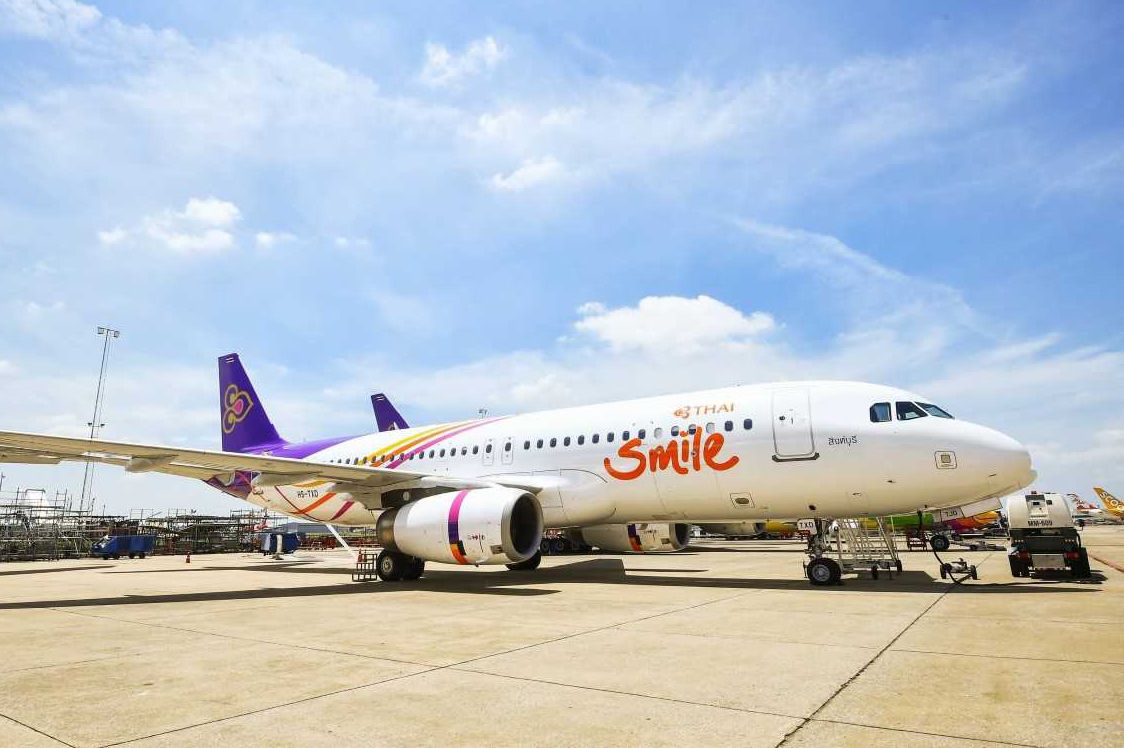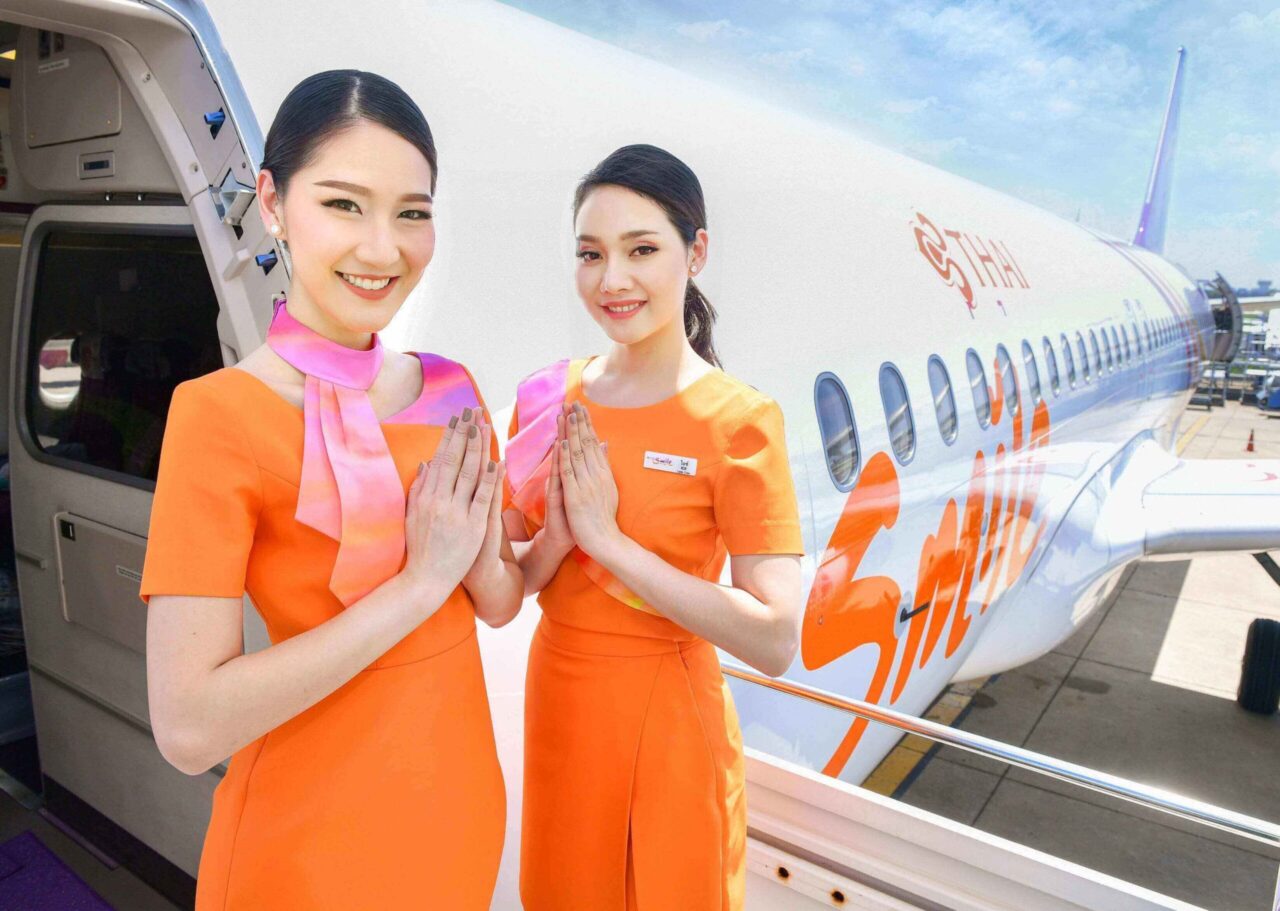EXCLUSIVE: Thai Smile’s Acting CEO Viset Sontichai Sheds Light On The Airline’s Existence, Now And In The Future
Note: Thai language version of article is lower down หมายเหตุ: บทความภาษาไทยอยู่ด้านล่าง
Viset Sontichai, who took the helm of Thai Airways International’s short-haul operation Thai Smile Airways barely a month ago, has set the record straight on whether the airline will still be around.
Viset says he has received a mandate from parent Thai Airways International management for Thai Smile to continue to operate under the same corporate structure and business model laid down before.
“Thai Smile will continue on the same basis as we have had, nothing has been suggested otherwise,” Viset, 55, tells the Smart Aviation Asia Pacific.
That clarification quells some lingering questions from the industry that Thai Smile would be disbanded and merged with Thai Airways because of its heavy losses and doubtful viability made worse by the pandemic.
The questions re-emerged after Thailand’s Central Bankruptcy Court in June cleared the last hurdle for implementing the ambitious rehabilitation plan of the beleaguered flag carrier saddled with 410 billion baht (US$12.8 billion) of debts.
Thai Airways’ turnaround plan does have ramifications for Thai Smile, a wholly-owned subsidiary established as a separate company but run as a business unit under the 61-year-old flag carrier’s umbrella.
Meanwhile, its debts amounted to 10.77 billion baht at the end of 2019.
Asked whether the heavy losses and debts are the cause of his concerns, Viset says those issues rest in the good hands of Thai Airways’ rehabilitation plan administrators.
“What I can say is we do the best in our part to stay afloat and then make a good recovery.”
Status quo
Viset, a Thai Airways veteran with over three decades of service, reiterates that Thai Smile will continue to serve as the domestic and regional wings of Thai Airways on short-haul routes – of up to four flight hours – providing full service, not a no-frills airline as some have erroneously referred to it as.
The airline’s passengers include medium and long-haul passengers transferring from full-service Thai Airways and other international carriers, especially Star Alliance member airlines, and travelling onwards to Thai domestic and regional destinations.
In February 2020, Thai Smile became a Star Alliance Connecting Partner which allows it to connect to the Star Alliance network without becoming a member airline.

Survival mode
Viset makes no bones about the airline’s financial struggles as it tries to secure cash flows amid dwindling revenues caused by the pandemic.
“We have been facing acute cash flow problems, just like most airlines around the world, because of revenue deprivation,” he says.
“Our top priority now is addressing the cash flow issues, and surviving through this year,” he adds.
Since the onset of the coronavirus pandemic in 2019, Thai Smile has gone through many critical times financially because it has been unable to operate regularly nor fully utilize its fleet of 20 Airbus 320s which have spent more time on the ground than in the air.
He credits the airline’s ability to survive these difficult times to the sacrifices of the airline’s staff – for accepting pay-cuts of 10-50%, depending on their rank; and some furloughing – as well as stringent cost control measures.
Back on track
Thai Smile’s focus now is to return as many single-aisle jets to service as possible and achieve decent frequencies as soon as possible – an exercise that will tackle its revenue shortfall woes.
Thanks to Thailand’s move towards easing of COVID-19-related travel restrictions, Thai Smile last month resumed domestic services to 11 Thai cities including Chiang Mai, Chiang Rai, Nan, Ubon Ratchathani, Udon Thani, Khon Kaen, Phuket, Krabi, Hat Yai, Surat Thani and Narathiwat; albeit with very limited frequencies largely due to weak demand.
The airline wishes to ramp up frequencies on those domestic routes, revive other domestic flights, and reintroduce the so-called ‘regional links’ such as from Udon Thani in the northeast to the southern province of Nakhon Si Thammarat.
By November and December this year, it should be able to restore all domestic routes to the pre-COVID levels as the government reopens the country to travel and travel sentiment returns, says Viset.
He says a gradual return to normality would mean that Thai Smile should be able to utilise more aircraft: from only six in September to ten this month, to 15 in November, 17 in December, 18 in January next year and 20 by March.
“That is based on a best-case scenario of air travel recovery, relaxation of COVID-19 travel restrictions and borders reopening become reality,” he stresses.
Overseas services
Thai Smile wants to restart its international services as early as November, in line with the government’s plan to re-open the country to foreign tourists with the easing of quarantine requirements.
On its radar screen for immediate resumption are flights to: Cambodia, Laos, Myanmar, Vietnam, Singapore, Malaysia, Sri Lanka, Bangladesh and Nepal.
The airline would very much like to return to the big markets of India and China which have shown no signs of reopening its borders, says Viset.
Prior to COVID, Thai Smile served 22 international routes from its base at Bangkok’s Suvarnabhumi Airport. These were to: Yangon and Mandalay in Myanmar, Siem Reap and Phnom Penh in Cambodia, Penang and Kuala Lumpur in Malaysia, Vientiane and Luang Prabang in Laos, and Hong Kong.
In addition, it served Chansha, Chongqing and Zhengzhou in China; Kaohsiung in Taiwan; Mumbai, Lucknow, Gaya, Varanasi, Kolkata, Jaipur and Ahmedabad in India; as well as the Phuket-Hong Kong and Chiang Mai-Kaohsiung routes.
The airline has resources and capabilities ready to launch these international services once the authorities give the ‘green light’, says Viset.
The airline’s personnel, whose numbers have declined to about 800 now from 1,100 last year, are ready to return to work in full force, he adds.
The split of the airline’s domestic and international revenue is now projected to be 50:50 from 60:40 previously.

Cargo
Thai Smile has also been active in freight since early this year when passenger traffic dried up.
It is using air cargo as vital revenue that it would never have considered previously as pivotal to its business.
Viset explains: “The airline’s all A320s are not designed to carry air freight containers and the cargo loads in their bellies are restricted to only nine tonnes each.
“Looking from any perspective, our aircraft are not ideal for moving cargo in the strictest sense.”
Aspiration
Thai Smile is still hopeful of breaking even and being in the black when the overall airline industry situation improves, probably in the next two years, says Viset.
Its balance sheet in 2021 will still be in the red, but the size of losses was lower than the previous year, he says.
It also aims to re-build revenues to pre-pandemic volumes, at 14.57 billion baht in 2019, and is pursuing digital transformation initiatives which allow its passengers to obtain all services on their mobile phones.
Picture Source: Thai Smile
Featured photo shows Thai Smile Airways’ acting CEO Viset Sontichai: A mission to put the smile back on the airline.
Thai language version of article:
สัมภาษณ์: วิเศรษฐ์ สนธิชัย รักษาการประธานเจ้าหน้าที่บริหาร ไทยสมายล์แอร์เวยส์ ให้ความกระจ่างเกี่ยวกับการดำรงอยู่ของสายการบินทั้งในปัจจุบันและอนาคต
บุญส่ง โฆษิต
นาย วิเศรษฐ์ สนธิชัย ซึ่งเพิ่งเข้าดำรงตำแหน่งผู้นำการดำเนินงานการบินระยะใกล้ของการบินไทย ในนาม สายการบินไทยสมายล์ เมื่อเดือนที่แล้ว ได้แสดงความชัดเจนว่า สายการบินจะยังคงอยู่ต่อไปหรือไม่
นายวิเศรษฐ์กล่าวว่า เขาได้รับมอบอำนาจจากผู้บริหารการบินไทย ซึ่งเป็นบริษัทแม่ ว่าให้ไทยสมายล์ ดำเนินการภายใต้โครงสร้างองค์กร และรูปแบบธุรกิจเดิมที่วางไว้ก่อนหน้านี้ต่อไป
“ไทยสมายล์จะดำเนินต่อไปบนพื้นฐานเดียวกันกับที่เรามี ไม่มีอะไรเป็นอย่างอื่น” ผู้บริหารวัย 55 ปี บอกกับ Smart Aviation Asia Pacific
การชี้แจงดังกล่าวช่วยขจัดคำถามที่ค้างคาจากอุตสาหกรรมว่า ไทยสมายล์ จะถูกยุบ และควบรวมกิจการกับการบินไทย เนื่องจากการขาดทุนต่อเนื่องเสียอย่างหนัก และความกังขาของความไมไม่ยั่งยืนของกิจการที่ซึ่งเลวร้ายลงจากการระบาดใหญ่ของโควิด
คำถามเกิดขึ้นอีกครั้ง หลังจากศาลล้มละลายกลางของไทยในเดือนมิถุนายนได้ขจัดอุปสรรคสุดท้ายสำหรับการดำเนินการตามแผนฟื้นฟูกิจการที่มีความทะเยอทะยานของสายการบินแห่งชาติ ที่ประสบปัญหามีหนี้สินจำนวน 410 พันล้านบาท (12.8 พันล้านดอลลาร์สหรัฐ)
แผนฟื้นฟูของการบินไทยนั้น มีผลกระทบต่อเนื่องกับไทยสมายล์ ซึ่งเป็นบริษัทในเครือที่จัดตั้งขึ้นเป็นบริษัทแยกต่างหาก แต่ดำเนินการเป็นหน่วยธุรกิจภายใต้ร่มของสายการบินแห่งชาติที่ให้บริการมา 61 ปีแล้ว
ในขณะเดียวกันหนี้ของไทยสมายล์ พอกพูนขึ้นเป็น 10.77 พันล้านบาท ณ สิ้นปี 2562
เมื่อถูกถามว่าการขาดทุน และหนี้สินจำนวนมากเป็นสาเหตุของความกังวลหรือไม่ นายวิเศรษฐ์กล่าวว่า ปัญหาเหล่านั้นอยู่ในมือของผู้บริหารแผนฟื้นฟูกิจการการบินไทย
“สิ่งที่ผมสามารถพูดได้คือเราทำสิ่งที่ดีที่สุดในส่วนของเรา เพื่อให้กิจการลอยลำอยู่ได้ และจากนั้นก็ฟื้นตัวได้ดี”
สภาพที่เป็นอยู่
นายวิเศรษฐ์ บุคลากรของการบินไทยที่มีประวัติการทำงานกว่าสามทศวรรษ ย้ำว่า ไทยสมายล์ จะยังคงทำหน้าที่เป็นผู้ไห้การบริการการบินภายในประเทศ และภูมิภาคของการบินไทยในเส้นทางระยะสั้น-สูงสุดสี่ชั่วโมงบิน ให้บริการเต็มรูปแบบไม่ใช่สายการบินต้นทุนต่ำที่บางคนเรียกผิดบ่อยๆ
ผู้โดยสารของสายการบินประกอบด้วย ผู้โดยสารระยะกลางและระยะไกลที่เปลี่ยนเครื่องจากการบินไทยที่ให้บริการเต็มรูปแบบ และสายการบินระหว่างประเทศอื่น ๆ โดยเฉพาะสายการบินสมาชิกกลุ่ม Star Alliance เพื่อเดินทางต่อไปยังจุดหมายปลายทางภายในประเทศและภูมิภาค
ในเดือนกุมภาพันธ์ 2563 ไทยสมายล์กลายเป็น Star Alliance Connecting Partner ซึ่งทำให้สามารถเชื่อมต่อกับเครือข่าย Star Alliance ได้โดยไม่ต้องเป็นสมาชิกสายการบิน
โหมดเอาชีวิตรอด
นายวิเศรษฐ์ ยอมรับว่า ไทยสมายล์ กำลังดิ้นรนกับปัญหาทางการเงิน โดยพยายามรักษากระแสเงินสด ท่ามกลางรายรับที่ลดน้อยลงจากการระบาดใหญ่
“เราประสบปัญหากระแสเงินสดอย่างสาหัส เช่นเดียวกับสายการบินส่วนใหญ่ทั่วโลก เนื่องจากการขาดรายได้อย่างมาก” เขากล่าว
“สิ่งสำคัญที่สุดของเราในตอนนี้ คือการจัดการกับปัญหากระแสเงินสด และอยู่รอดให้ได้ผ่านปีนี้” เขากล่าวเสริม
นับตั้งแต่เริ่มมีการระบาดของโคโรนาไวรัสในปี 2562 ไทยสมายล์ได้ผ่านช่วงเวลาวิกฤตทางการเงินมาหลายครั้ง เนื่องจากไม่สามารถดำเนินการได้ตามปกติ หรือใช้ฝูงบินแอร์บัส 320 จำนวน 20 ลำอย่างเต็มที่ ซึ่งใช้เวลาอยู่บนพื้นดินมากกว่าในอากาศ
เขาให้เครดิตความสามารถของสายการบินในการเอาชีวิตรอดในช่วงเวลาที่ยากลำบากเหล่านี้จากการเสียสละของพนักงานสายการบิน – สำหรับการยอมรับการลดค่าจ้าง 10-50% ขึ้นอยู่กับตำแหน่งงาน และการพักงานบางส่วน – ตลอดจนมาตรการควบคุมต้นทุนที่เข้มงวด
กลับสู่เส้นทาง
เป้าหมายของไทยสมายล์ในตอนนี้ คือนำเครื่องบินทางเดินเดี่ยวกลับไปบินให้มากที่สุดเท่าที่จะเป็นไปได้ และบรรลุความถี่ที่เหมาะสมโดยเร็วที่สุด ซึ่งเป็นหนทางที่จะจัดการกับปัญหารายได้ที่ขาดแคลน
ด้วยความเคลื่อนไหวของประเทศไทยในการผ่อนคลายข้อจำกัดการเดินทางที่เกี่ยวข้องกับโควิด-19 เมื่อเดือนที่แล้ว ไทยสมายล์กลับมาให้บริการในประเทศสู่ 11 เมืองอีกครั้ง รวมถึงเชียงใหม่ เชียงราย น่าน อุบลราชธานี อุดรธานี ขอนแก่น ภูเก็ต กระบี่ หาดใหญ่ สุราษฎร์ธานี และ นราธิวาส แม้ว่าจะมีความถี่ที่จำกัดมากเนื่องจากความต้องการที่ยังต่ำอยู่แอ
สายการบินมีความประสงค์ที่จะเพิ่มความถี่ในเส้นทางในประเทศเหล่านั้น ฟื้นฟูเที่ยวบินภายในประเทศอื่นๆ และให้บริการเชื่อมโยงภูมิภาคต่างๆ อีกครั้ง เช่น จากอุดรธานีในภาคตะวันออกเฉียงเหนือไปยังนครศรีธรรมราชในภาคใต้
ภายในเดือนพฤศจิกายนและธันวาคมปีนี้ ไทยสมายล์จะสามารถฟื้นฟูเส้นทางภายในประเทศทั้งหมดให้อยู่ในระดับก่อนเกิดโควิดได้ เนื่องจากรัฐบาลเปิดประเทศอีกครั้งเพื่อเดินทางและความรู้สึกการเดินทางกลับคืนมา นายวิเศรษฐ์กล่าว
เขากล่าวว่าการกลับสู่สภาวะปกติอย่างค่อยเป็นค่อยไปจะทำให้ไทยสมายล์สามารถใช้เครื่องบินได้มากขึ้น: จากเพียง 6 ลำในเดือนกันยายนเป็น 10 ลำในเดือนนี้ เป็น 15 พฤศจิกายน 17 ในเดือนธันวาคม 18 ในเดือนมกราคมปีหน้า และในที่สุด 20 ในเดือนมีนาคม
“นั่นอิงจากสถานการณ์ที่ดีที่สุดเมื่อการฟื้นการเดินทางทางอากาศ การผ่อนคลายข้อจำกัดการเดินทางของโควิด-19 และการเปิดพรมแดนอีกครั้งกลายเป็นความจริง” เขากล่าว
บริการต่างประเทศ
ไทยสมายล์ต้องการเริ่มให้บริการระหว่างประเทศอย่างเร็วที่สุดในเดือนพฤศจิกายนนี้ ตามแผนของรัฐบาลในการเปิดประเทศอีกครั้งสำหรับนักท่องเที่ยวต่างชาติ โดยมีการผ่อนปรนข้อกำหนดการกักกัน
บนหน้าจอเรดาร์สำหรับการเริ่มต้นใหม่ทันทีจะมีเที่ยวบินไปยัง กัมพูชา ลาว เมียนมาร์ เวียดนาม สิงคโปร์ มาเลเซีย ศรีลังกา บังคลาเทศ และเนปาล
สายการบินต้องการกลับไปสู่ตลาดใหญ่ของอินเดียและจีนเป็นอย่างมาก แต่ไม่มีวี่แววว่าจะมีการเปิดพรมแดนอีกครั้งเมื่อไร นายวิเศรษฐ์กล่าว
ก่อนเกิดโรคโควิด-19 ไทยสมายล์ให้บริการเส้นทางระหว่างประเทศ 22 เส้นทางจากฐานที่สนามบินสุวรรณภูมิในกรุงเทพฯ ได้แก่ ย่างกุ้ง และมัณฑะเลย์ ในเมียนมาร์ เสียมราฐ และพนมเปญในกัมพูชา ปีนัง และกัวลาลัมเปอร์ในมาเลเซีย เวียงจันทน์ และหลวงพระบางในประเทศลาว และฮ่องกง
นอกจากนี้ยังให้บริการไปยัง ฉางซา ฉงชิ่ง และ เจิ้งโจว ในประเทศจีน เกาสงในไต้หวัน มุมไบ ลัคเนา คยา พาราณสี โกลกาตา ชัยปุระ และอาเมดาบัดในอินเดีย เส้นทางภูเก็ต-ฮ่องกง และเชียงใหม่-เกาสง
สายการบินมีทรัพยากรและความสามารถพร้อมที่จะเปิดให้บริการระหว่างประเทศเหล่านี้เมื่อทางการได้ให้ “ไฟเขียว” นายวิเศรษฐ์ กล่าว
บุคลากรของสายการบินซึ่งขณะนี้ลดลงเหลือประมาณ 800 คนจาก 1,100 คนในปีที่แล้ว พร้อมที่จะกลับมาปฏิบัติงานอย่างเต็มกำลัง เขากล่าวเสริม
การแบ่งรายได้ในและต่างประเทศของสายการบินในขณะนี้คาดว่าจะเป็น 50:50 จาก 60:40 ก่อนหน้านี้
ขนส่งสินค้าทางอากาศ
ไทยสมายล์ยังดำเนินการด้านการขนส่งสินค้าตั้งแต่ต้นปีนี้เมื่อปริมาณผู้โดยสารลดลง
โดยการขนส่งสินค้าทางอากาศสร้างรายได้ที่สำคัญในแบบที่ไม่เคยเป็นมาก่อน
เขาอธิบายว่า: “เครื่องบิน A320 ทั้งหมดของสายการบินไม่ได้ออกแบบมาเพื่อบรรทุกตู้คอนเทนเนอร์ขนส่งสินค้าทางอากาศ และบรรทุกสินค้าในใต้ท้องได้ลำละเพียงเก้าตันเท่านั้น
“เมื่อมองจากมุมมองใดๆก็ตาม เครื่องบินของเราไม่เหมาะสำหรับการเคลื่อนย้ายสินค้ามาก ถ้าตีความแบบเข้มงวดที่สุด”
ความทะเยอทะยาน
ไทยสมายล์ยังคงมีความหวังที่จะเข้าสู่จุดคุ้มทุน และหลุดจากตัวแดงทางบัญชี เมื่อสถานการณ์โดยรวมของอุตสาหกรรมสายการบินดีขึ้น ซึ่งอาจเป็นไปได้ในอีก 2 ปีข้างหน้า นายวิเศรษฐ์บอก
งบดุลในปี 2564 จะยังคงเป็นสีแดง แต่จำนวนขาดทุนจะต่ำกว่าปีที่แล้ว
นอกจากนี้ยังตั้งเป้าที่จะสร้างรายได้อีกครั้งในระดับก่อนเกิดโรคระบาดที่ 14.57 พันล้านบาทในปี 2562 และกำลังดำเนินการตามความคิดริเริ่มในการเปลี่ยนแปลงทางดิจิทัลที่ช่วยให้ผู้โดยสารได้รับบริการทั้งหมดผ่านบนโทรศัพท์มือถือของตน
Related Stories:
Thai Airways’ Mounting Challenges (22 September 2021)
INTERVIEW: Thai AirAsia Executive Chairman Tassapon Bijleveld On The Carrier’s Flights Through Unrelenting COVID-19 Storms (13 September 2021)
Follow us on facebook and twitter for more news updates.

